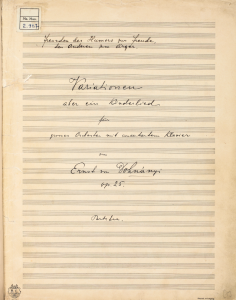
Variations on a Nursery Tune
Variations on a Nursery Tune. Változatok egy gyermekdalra
Ernst von Dohnányi: Variations on a Nursery Tune. Variationen über ein Kinderlied
Facsimile edition
Accompanying study written by Éva Kelemen
NSZL, Budapest, 2017.
104 sheet music pages + 32 pages of the essay
ISBN 979 080 167 029 8
Ernst von Dohnányi (1877–1960), pianist, composer, conductor and music teacher, was one of the most versatile musicians of the 20th century. This image of him is supported by his virtuosic success piece Variationen über ein Kinderlied für grosses Orchester mit concertantem Klavier, op. 25 (Variations on a Nursery Tune for piano and orchestra, Op. 25), now published in a facsimile edition, too. The manuscript score is one of the seventeen manuscripts handed over in 1959 to the national library’s Music Collection during the composer's lifetime, a decision which underlined his intention to preserve his national intellectual heritage. But the manuscript published on the occasion of the 140th anniversary of the composer's birth is significant not only as one of the representative documents in the collection. The score reveals to the reader the whole creative process, the compositional dynamics of the variations, the formation and transformation of the orchestration, and how Ernst von Dohnányi's best-known composition was born.
The composer was able to use his compositional inspiration with great intuition in the improvisational genres, including variation, which, as his oeuvre as a whole attests, played a prominent role in his creative process and accompanied him throughout his career. He often played variations at concerts and performed works by Beethoven, Brahms and Chopin alongside his own pieces. It is no coincidence, therefore, that he chose this tried-and-tested form when writing his large-scale orchestral work Variations on a Nursery Tune, 1913–1914, which he completed with a piano solo.
The short description above is based on the introductory essay by Éva Kelemen.
Shopping
Our publications are available in our bookshop, or can be ordered from the Publications Department of the NSZL using the contact details below: Főigazgatói Kabinet kiadványtára, Országos Széchényi Könyvtár, 1276 Budapest P.O. box 1205., phone: 06 1 232-3556, e-mail: kiadvanytar@oszk.hu.




